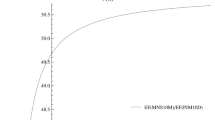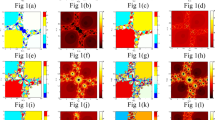Abstract
Given a univariate real polynomial, this paper considers calculating all the real zero-points of the polynomial simultaneously. Among several numerical methods for calculating zero-points of a univariate polynomial, Durand-Kerner method is quite useful because it is most stable to converge to the zero-points. On the basis of Durand-Kerner method, we propose two methods for calculating the real zero-points of a univariate polynomial simultaneously. Convergence and error analysis of our methods are discussed. We compared our methods, the original Durand-Kerner method and Newton’s method and found that 1) our methods are more stable than Newton’s method but less than the original Durand-Kerner method, and 2) they are more efficient than the original Durand-Kerner method but less than Newton’s method. We conclude that our methods are useful when good initial values of the zero-points are known.
Similar content being viewed by others

References
O. Aberth, Iteration methods for finding all zeros of a polynomial simultaneously. Math. Comp.,27 (1973), 339–344.
E. Durand, Solutions Numériques des Équations Algébriques (Tome I). Masson, Paris, 1960.
P.P. Fraigniaud, The Durand-Kerner polynomials roots-finding method in case of multiple roots. BIT,31, No. 1 (1991), 112–123.
M. Iri, Numerical Analysis (in Japanese). Asakura Publishing Co., Tokyo, 1981.
I.O. Kerner, Ein Gesamtschrittverfahren zur Berechnung der Nullstellen von Polynomen. Numer. Math.,8 (1966), 290–294.
M. Natori, Numerical Analysis and its Applications (in Japanese). Corona Publishing Co., Tokyo, 1990.
L. Pasquini and D. Trigiante, A globally convergent method for simultaneously finding polynomial roots. Math. Comp.,44, No. 169 (1985), 135–149.
M.S. Petkovic, D.D. Herceg and S.M. Ilić, Point Estimation Theory and its Applications. Institute of Mathematics, University of Novi Sad, Novi Sad, 1997.
T. Sasaki, Formula manipulation system GAL. Computing in High Energy Physics ’91 (eds. Y. Watase and F. Abe, Tsukuba, 1991), Universal Academy Press, Tokyo, 1991, 383–389.
B.T. Smith, Error bounds for zeros of a polynomial based upon Gerschgorin’s theorems. J. ACM,17, No. 4 (1970), 661–674.
T. Takagi, Lectures in Algebra (in Japanese, revised ed.). Kyōritsu Publishing Co., Tokyo, 1965.
T. Yamamoto, S. Kanno and L. Atanassova, Validated computation of polynomial zeros by the Durand-Kerner method. Topics in Validated Computations (Oldenburg, 1993), North-Holland, Amsterdam, 1994, 27–53.
Author information
Authors and Affiliations
About this article
Cite this article
Terui, A., Sasaki, T. Durand-Kerner method for the real roots. Japan J. Indust. Appl. Math. 19, 19–38 (2002). https://doi.org/10.1007/BF03167446
Received:
Revised:
Issue Date:
DOI: https://doi.org/10.1007/BF03167446



